Keeping flies away from your dog naturally is achievable through various methods. Flyermedia.net offers practical solutions to protect your pet from these annoying pests. Implementing good hygiene practices, using natural repellents, and maintaining a clean environment are essential steps. By understanding these strategies, you can ensure your furry friend stays comfortable and fly-free.
Are you looking for natural ways to keep those pesky flies away from your beloved dog? Flies are not only irritating, but they can also pose health risks to your furry friend. Luckily, Flyermedia.net offers expert advice on fly control for dogs using safe, effective, and natural methods. Learn how to create a fly-free zone for your canine companion, focusing on pet hygiene, natural insect repellents, and environmental management. Let’s explore the best strategies for dog fly protection and ensuring your pet’s well-being, creating a healthier, happier life for both of you.
1. Why Are Flies Attracted to Your Dog?
Flies are attracted to dogs for several reasons, often related to hygiene and health. Understanding these attractions can help prevent fly infestations.
Several factors can attract flies to your dog, making them a nuisance and potential health hazard. Flies are drawn to odors, open wounds, and unsanitary conditions, all of which can be associated with dogs. Recognizing these attractants is the first step in keeping flies away from your canine companion.
1.1. Unclean Coat and Matted Fur
If your dog has a matted or unclean coat due to skin conditions, illness, or diarrhea, it can attract flies. Flies are drawn to the odors and debris that accumulate in dirty fur, especially around the perineum near your dog’s anus.
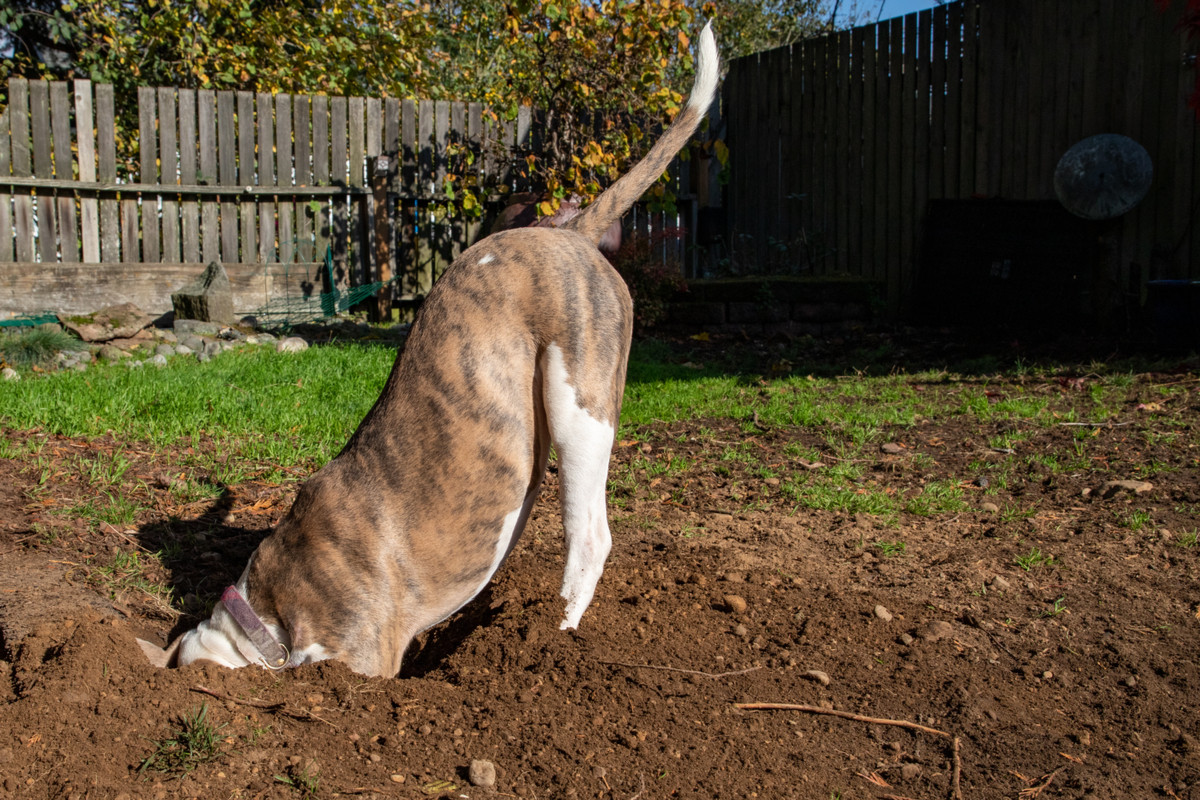 dog digging hole in a yard
dog digging hole in a yard
1.2. Fecal Matter
Flies often lay eggs on fecal matter, which then hatch into maggots. If fecal matter is caked around your dog’s anus, it becomes an ideal breeding ground for flies. Maggots can cause infestations and serious health problems if left untreated.
1.3. Open Wounds and Sores
Flies are attracted to open wounds and sores, as they seek out protein-rich sources for laying eggs. These areas can become infected if flies are allowed to land and deposit their eggs, leading to further complications.
1.4. Ear Bites
Certain types of flies, such as horseflies, are known to bite dogs’ ears and rear ends. These bites can bleed, become infected, and cause significant irritation to your dog.
1.5. Illness and Inability to Self-Clean
Sick dogs often have difficulty keeping themselves clean, making them more attractive to flies. It’s essential to help your dog stay clean, especially when they are ill, to prevent fly infestations.
1.6. Environmental Factors
Your dog’s environment plays a crucial role in attracting or repelling flies. Food left out, uncleaned kennel areas, and accumulated trash can all draw flies to your dog’s vicinity.
2. What Are the Best Natural Ways to Keep Flies Off Dogs?
Keeping flies off your dog naturally involves maintaining cleanliness, using safe repellents, and managing the environment. Here are effective methods to keep flies away.
Maintaining cleanliness, utilizing natural repellents, and managing your dog’s environment are effective, safe ways to keep flies away. Regular grooming, strategic use of essential oils, and consistent cleaning routines can significantly reduce fly infestations. According to the American Kennel Club, proactive measures are vital for ensuring your dog’s comfort and health.
2.1. Keep Your Dog Clean and Healthy
Regular grooming and bathing are essential for keeping flies away from your dog. Flies are attracted to dirt and odors, so maintaining a clean coat is crucial.
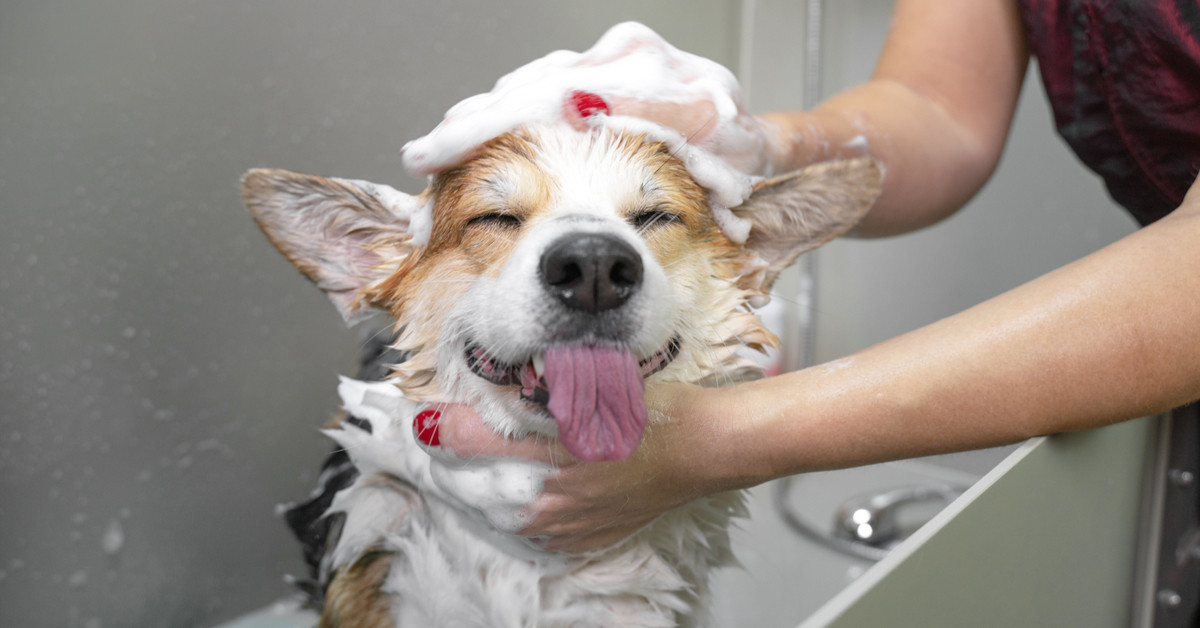 how often should a dog be groomed
how often should a dog be groomed
2.2. Regular Grooming
Groom your dog regularly to remove dirt and debris that can attract flies. Pay special attention to the areas around the genitals and anus, keeping them clean and trimmed to prevent matting.
2.3. Regular Bathing
Bathe your dog regularly with a pet-friendly shampoo to keep their coat clean and free of odors. This helps to eliminate attractants for flies.
2.4. Petroleum Jelly for Ear Bites
Apply petroleum jelly to your dog’s ears if they are being bitten by flies. This creates a barrier that prevents flies from biting and helps to soothe irritated skin.
2.5. Safe Insect Repellents
Use safe insect repellents such as apple cider vinegar or lemongrass essential oil to keep flies away. These natural options are less likely to cause adverse reactions compared to chemical-based products.
2.6. Apple Cider Vinegar
Dilute apple cider vinegar with water (50/50 ratio) and spray it on your dog’s coat. The acidic nature of apple cider vinegar repels flies.
2.7. Lemongrass Essential Oil
Lemongrass essential oil has been proven to repel stable flies. Dilute a few drops of lemongrass oil in water and spray it on your dog’s coat, avoiding the eyes, nose, and mouth.
2.8. Other Essential Oils
Other essential oils with fly repellent properties include Idaho tansy, geranium, sandalwood, rosemary, and lavender. Always dilute essential oils before applying them to your dog’s skin.
2.9. DIY Essential Oil Spray
Create your own essential oil fly spray by diluting 5-10 drops of your preferred essential oil in a 32-ounce spray bottle filled with distilled water. Shake well before each use.
2.10. Consult Your Veterinarian
Consult your veterinarian before applying any topical treatments, including essential oils, to ensure they are safe for your dog. Some oils can cause gastrointestinal irritation if ingested.
2.11. Keep Your Dog’s Environment Clean
Maintaining a clean environment is crucial for preventing fly infestations. Regular cleaning of your dog’s living area helps to eliminate attractants and breeding grounds for flies.
 dog food being eaten
dog food being eaten
2.12. Pick Up Dog Food
Pick up your dog’s food bowl immediately after they finish eating. Leftover food attracts flies and can lead to infestations.
2.13. Wash Dog Bedding
Wash your dog’s bedding at least once a week with pet-friendly soap and hot water. This helps to remove stains, odors, and fly eggs.
2.14. Baking Soda
Sprinkle baking soda on the bedding after washing to eliminate lingering odors. Leave it on for about 15 minutes and then vacuum it up.
2.15. Clean Kennel Area
Keep your dog’s kennel area clean by removing bones, food, and other debris that can attract flies. A clean kennel reduces the risk of fly infestations.
2.16. Clean Up Dog Poop
Flies are attracted to dog feces, where they lay eggs. Clean up your yard regularly to remove this breeding ground and reduce the fly population.
2.17. Clean Up Trash
Keep your home and yard free of trash. Garbage attracts flies, which can then move on to your dog.
2.18. Vacuum Carpets
Vacuum carpets several times a week to prevent fly infestations. Flies often lay eggs in carpets, and regular vacuuming can help to remove them.
2.19. Empty Vacuum Bag
Empty the vacuum bag outside to prevent fly eggs from hatching indoors.
2.20. Fly Traps
Hang up fly traps, such as Venus fly traps or sugar water traps, to attract and capture flies. These traps can help to reduce the fly population in your home and yard.
2.21. Sugar Water Trap
Make a sugar water trap by mixing sugar and water in a container with a narrow opening. Flies will enter the trap but be unable to escape.
2.22. Natural Pesticides
Use natural pesticides to repel flies. Products containing citronella, lemongrass oil, catnip, coconut oil, and peppermint oil are effective and safe for use around pets.
2.23. Citronella
Citronella is a well-known natural insect repellent. Use citronella candles or sprays to keep flies away from your dog’s environment.
2.24. Catnip
Catnip has been proven to repel flies. Plant catnip in your yard or use catnip sprays to deter flies.
2.25. Coconut Oil
Coconut oil is a safe and effective natural fly repellent. Apply a thin layer of coconut oil to your dog’s coat to keep flies away.
2.26. Peppermint Oil
Place peppermint oil around your home in areas where pests may enter. Peppermint oil repels various insects, including flies.
3. What Essential Oils Are Poisonous for Dogs?
Some essential oils can be harmful to dogs and should be avoided. Knowing which oils to avoid is crucial for your pet’s safety.
Protecting your dog from flies using essential oils can be effective, but it’s crucial to know which oils are safe. Some essential oils can be toxic to dogs, causing serious health issues. According to the ASPCA, certain oils can lead to liver damage, central nervous system issues, and respiratory problems in pets.
 pet safe essential oils for diffuser
pet safe essential oils for diffuser
3.1. Tea Tree Oil
Tea tree oil is highly toxic to dogs and can cause symptoms such as depression, incoordination, and seizures.
3.2. Pennyroyal
Pennyroyal oil can cause liver failure and seizures in dogs. It should be avoided entirely.
3.3. Oil of Wintergreen
Oil of wintergreen contains methyl salicylate, which is toxic to dogs. It can cause gastrointestinal upset, liver damage, and neurological issues.
3.4. Pine Oils
Pine oils can irritate your dog’s skin and mucous membranes. They can also cause central nervous system depression and respiratory problems.
3.5. Cinnamon Oil
Cinnamon oil can cause skin irritation and gastrointestinal upset in dogs. It’s best to avoid using it as a fly repellent.
3.6. Citrus Oils
While some citrus oils are considered safer than others, they can still cause skin irritation and gastrointestinal upset in dogs. Use them with caution.
3.7. Peppermint Oil
Although peppermint oil can repel insects, it can also be irritating to dogs if applied directly to their skin. Use it sparingly and avoid direct contact.
3.8. Sweet Birch Oil
Sweet birch oil contains methyl salicylate and is toxic to dogs. It can cause similar symptoms as oil of wintergreen.
3.9. Ylang-Ylang Oil
Ylang-ylang oil can cause skin irritation and central nervous system depression in dogs. It’s best to avoid using it as a fly repellent.
4. How to Keep Your Dog’s Environment Clean
Maintaining a clean environment is crucial for keeping flies away from your dog. Regular cleaning helps eliminate attractants and breeding grounds.
Maintaining a pristine environment for your dog is crucial to ward off flies. Regular cleaning routines, proper waste disposal, and diligent grooming practices are essential components of fly prevention. According to a study by the National Center for Biotechnology Information (NCBI), a clean environment significantly reduces the presence of flies and other pests.
4.1. Pick Up Your Dog’s Food
After your dog finishes eating, promptly remove the food bowl and wash it thoroughly. Leaving food out attracts flies, creating a breeding ground.
4.2. Wash Your Dog’s Bedding
Wash your dog’s bedding at least once a week to remove odors, stains, and potential fly eggs. Use a pet-friendly detergent and hot water for the best results.
4.3. Clean Your Dog’s Kennel Area
Regularly clean your dog’s kennel area to eliminate food scraps, feces, and other debris that attract flies. Use a pet-safe cleaner to disinfect the area.
4.4. Clean Up Your Dog’s Poop
Flies are highly attracted to dog feces, using it as a site to lay eggs. Clean up your yard and surrounding areas promptly to minimize fly attraction.
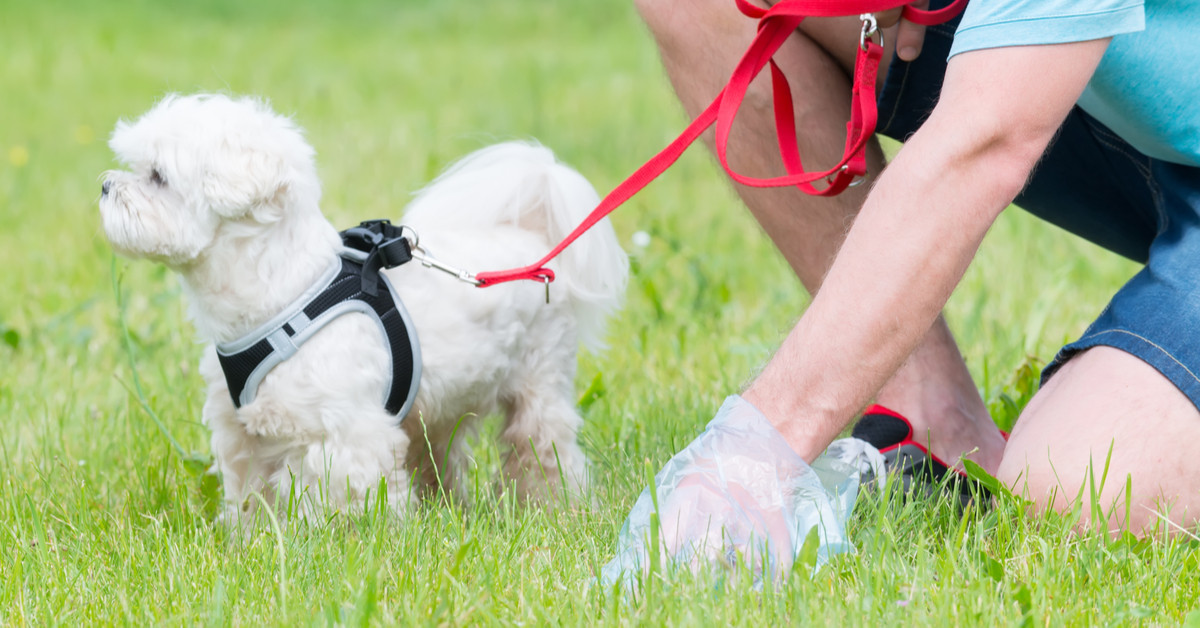 dog poop being cleaned
dog poop being cleaned
4.5. Clean Up the Trash Around Your Home
Ensure that trash cans are tightly sealed and emptied regularly to prevent odors that attract flies. Keep your home and yard free of garbage and debris.
4.6. Vacuum the Carpet
Vacuum carpets frequently to remove fly eggs and larvae that may be present. Focus on areas where your dog spends the most time.
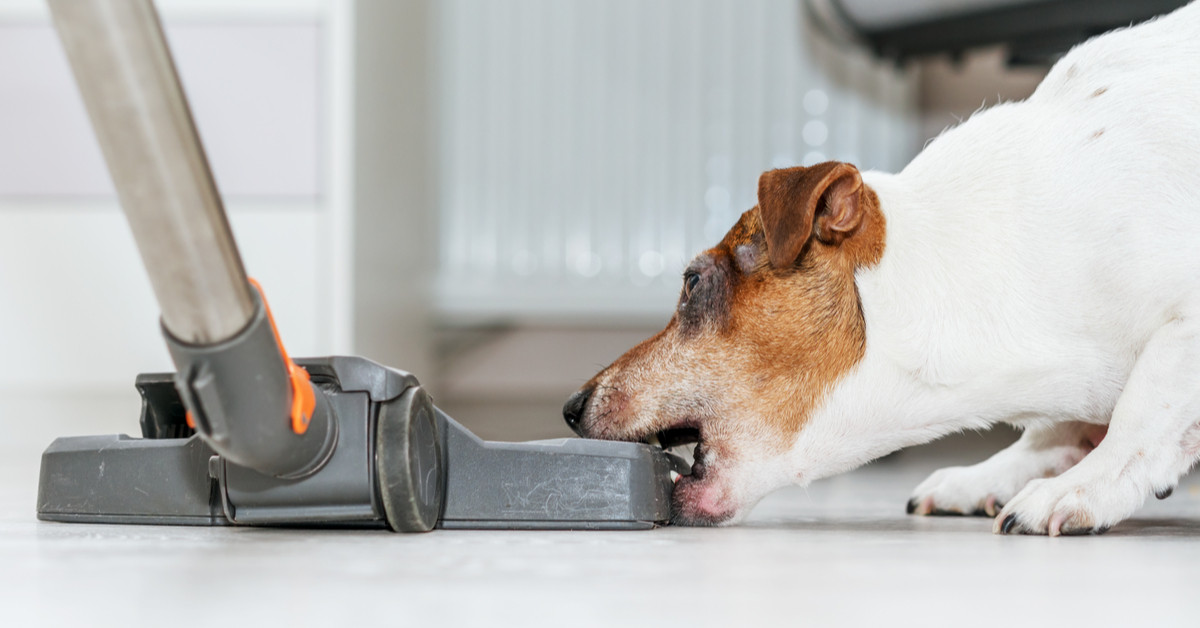 dog vacuuming
dog vacuuming
4.7. Hang Up Fly Traps
Strategically place fly traps around your home and yard to capture and eliminate flies. Options include sticky flypaper, electronic traps, and homemade traps.
4.8. Use Natural Pesticides to Repel Flies
Apply natural pesticides around your home to deter flies. Options include citronella candles, essential oil sprays, and herbal repellents.
5. What Not to Do When Getting Rid of Flies
Avoid using toxic insecticides and chemicals that can harm your dog. Opt for safe, natural methods to control flies.
When tackling fly infestations, avoid using harmful chemicals and insecticides that can endanger your dog’s health. Prioritize safe, natural alternatives for effective fly control. According to the Environmental Protection Agency (EPA), many commercial insecticides contain ingredients that can cause severe health issues in pets.
5.1. Avoid Toxic Insecticides
Refrain from using insecticides not specifically designed for dogs. These products often contain chemicals that can be harmful if ingested or absorbed through the skin.
5.2. Dilute Chemicals
If using any chemical-based fly control products, dilute them as much as possible to reduce the risk of toxicity. Follow the product’s instructions carefully.
5.3. Avoid Overuse
Do not overuse any fly control product, even if it is labeled as safe for pets. Excessive use can lead to health problems.
5.4. Keep Products Out of Reach
Store all fly control products out of reach of your dog to prevent accidental ingestion. Secure cabinets and containers are essential.
5.5. Monitor Your Dog
Monitor your dog for any signs of adverse reactions when using fly control products. Symptoms may include vomiting, diarrhea, skin irritation, or lethargy.
5.6. Consult a Professional
If you are unsure about which fly control methods are safe for your dog, consult a veterinarian or professional pest control service. They can provide tailored advice and safe solutions.
6. Effective Natural Fly Repellents for Dogs
Discover safe and effective natural fly repellents that won’t harm your dog. These alternatives provide a healthier way to protect your pet.
Discovering safe and effective natural fly repellents is essential for protecting your dog without exposing them to harmful chemicals. Natural alternatives, such as essential oils and herbal remedies, offer a healthier approach to fly control. According to research published in the Journal of Veterinary Internal Medicine, natural repellents can be as effective as chemical options when used correctly.
6.1. Citronella
Citronella oil is a well-known natural insect repellent. Use citronella candles or diluted citronella oil sprays to keep flies away from your dog’s environment.
6.2. Lemongrass Oil
Lemongrass oil is effective at repelling flies and other insects. Dilute a few drops of lemongrass oil with water and spray it around your dog’s living area.
6.3. Catnip
Catnip contains nepetalactone, which repels flies and mosquitoes. Plant catnip in your garden or use catnip sprays to keep pests away.
6.4. Coconut Oil
Coconut oil can be applied directly to your dog’s skin to repel flies. Its moisturizing properties also help to keep your dog’s coat healthy.
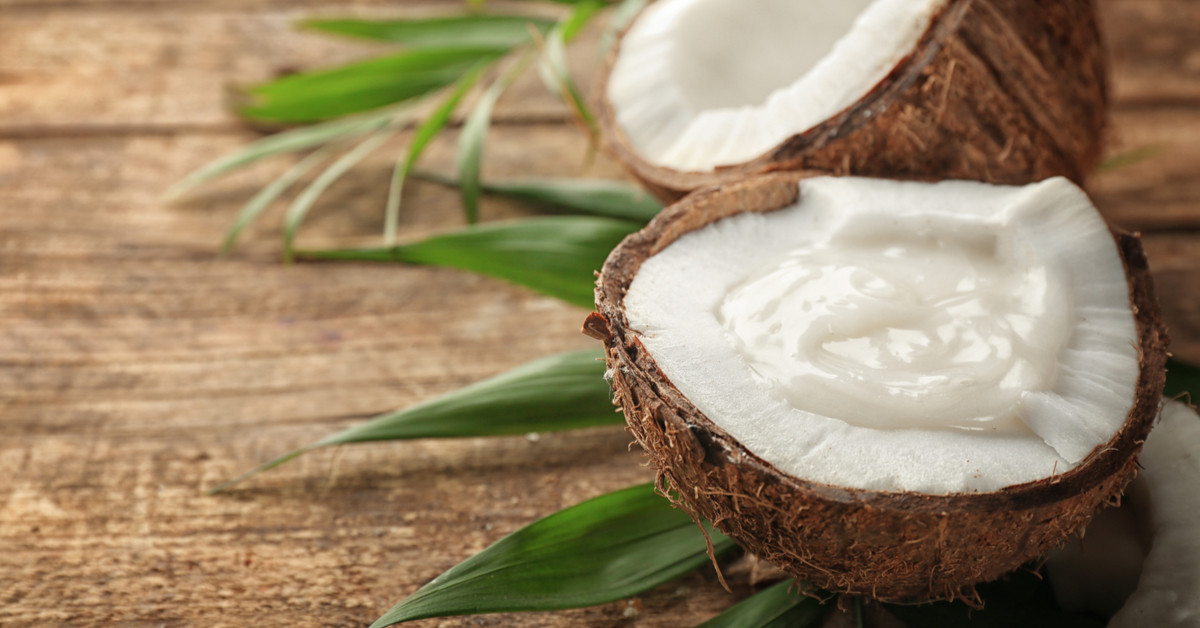 dog with coconut oil
dog with coconut oil
6.5. Peppermint Oil
Peppermint oil repels a variety of insects, including flies. Place cotton balls soaked in peppermint oil around your home to deter pests.
6.6. Eucalyptus Oil
Eucalyptus oil is an effective fly repellent. Dilute eucalyptus oil with water and spray it around your dog’s living area.
6.7. Lavender Oil
Lavender oil has insect-repelling properties and a calming scent. Use lavender oil sprays or plant lavender in your garden to keep flies away.
6.8. Apple Cider Vinegar
Apple cider vinegar can be sprayed directly onto your dog’s coat to repel flies. Dilute it with water to avoid skin irritation.
6.9. Neem Oil
Neem oil is a natural insecticide and repellent. Dilute neem oil with water and spray it around your dog’s living area.
6.10. Diatomaceous Earth
Diatomaceous earth is a natural powder made from fossilized algae. Sprinkle it around your yard to control fly larvae.
7. How to Identify Fly Bites on Your Dog
Learn to recognize fly bites on your dog to address them promptly. Early detection prevents potential infections and complications.
Identifying fly bites on your dog is crucial for timely treatment and preventing potential complications. Early detection can help prevent infections and alleviate your dog’s discomfort. According to the Veterinary Dermatology Group, recognizing the signs of fly bites is the first step in effective management.
7.1. Red Bumps
Fly bites often appear as small, red bumps on your dog’s skin. These bumps may be raised and inflamed.
7.2. Itching
Your dog may excessively scratch, bite, or lick the affected area due to itching. This can lead to further irritation and potential infection.
7.3. Hair Loss
Frequent scratching can cause hair loss around the bite area. This is particularly common in dogs with sensitive skin.
7.4. Scabs
Scabs may form over the bite area as the skin heals. These scabs can be itchy and uncomfortable for your dog.
7.5. Swelling
In some cases, the bite area may swell. This is more common with bites from certain types of flies, such as horseflies.
7.6. Hot Spots
Hot spots, or areas of inflamed, infected skin, can develop as a result of fly bites. These require prompt veterinary treatment.
7.7. Secondary Infections
Fly bites can become infected if bacteria enter the wound. Signs of infection include pus, redness, swelling, and pain.
7.8. Location of Bites
Fly bites are most common on areas of the body with thin skin, such as the ears, belly, and groin.
7.9. Behavioral Changes
Your dog may exhibit behavioral changes, such as restlessness, irritability, or reluctance to go outside, due to fly bites.
7.10. Allergic Reactions
In rare cases, dogs may have allergic reactions to fly bites. Signs of an allergic reaction include hives, facial swelling, and difficulty breathing.
8. What to Do If Your Dog Has a Fly Bite
Treating fly bites promptly can prevent complications. Here’s how to care for your dog’s bites.
Treating fly bites promptly is crucial to prevent complications and ensure your dog’s comfort. Addressing the bites with appropriate care can alleviate itching, reduce inflammation, and prevent secondary infections. According to the American Veterinary Medical Association (AVMA), proper wound care is essential for healing.
8.1. Clean the Bite Area
Gently clean the bite area with mild soap and water. This helps to remove dirt and bacteria that can cause infection.
8.2. Apply a Cold Compress
Apply a cold compress to the bite area to reduce swelling and relieve itching. Hold the compress in place for 10-15 minutes.
8.3. Use an Antiseptic
Apply a pet-safe antiseptic to the bite area to prevent infection. Povidone-iodine or chlorhexidine solutions are good options.
8.4. Apply an Anti-Itch Cream
Use a pet-safe anti-itch cream to relieve itching and inflammation. Hydrocortisone creams can be effective, but consult your veterinarian first.
8.5. Prevent Licking
Prevent your dog from licking the bite area, as this can introduce bacteria and delay healing. Use an Elizabethan collar if necessary.
8.6. Monitor for Infection
Monitor the bite area for signs of infection, such as pus, redness, swelling, and pain. Seek veterinary care if infection develops.
8.7. Use Natural Remedies
Natural remedies such as aloe vera gel or chamomile tea can soothe the bite area and relieve itching.
8.8. Consult Your Veterinarian
Consult your veterinarian if the bite area is severely inflamed, infected, or not healing properly.
8.9. Keep the Area Clean
Keep the bite area clean and dry to promote healing. Change dressings regularly if needed.
8.10. Prevent Future Bites
Take steps to prevent future fly bites by using insect repellents, keeping your dog’s environment clean, and avoiding areas with high fly populations.
9. Understanding Fly Strike in Dogs: Prevention and Treatment
Learn about fly strike, a severe condition caused by flies laying eggs on dogs, and how to prevent and treat it.
Understanding fly strike in dogs is essential for preventing this severe condition and ensuring prompt treatment if it occurs. Fly strike, also known as myiasis, results from flies laying eggs on a dog’s skin, leading to maggot infestations. According to the Merck Veterinary Manual, early detection and treatment are crucial for a positive outcome.
9.1. What is Fly Strike?
Fly strike occurs when flies lay eggs on a dog’s skin, particularly in areas that are soiled, wounded, or have open sores. The eggs hatch into maggots, which feed on the dog’s tissue.
9.2. Risk Factors
Dogs with matted fur, open wounds, fecal or urine staining, or limited mobility are at higher risk of fly strike. Neglected or debilitated animals are also more susceptible.
9.3. Signs of Fly Strike
Signs of fly strike include visible maggots on the skin, foul odor, skin irritation, pain, and lethargy. The affected area may appear inflamed and have discharge.
9.4. Prevention
Preventing fly strike involves maintaining good hygiene, keeping wounds clean and covered, and managing any underlying health conditions. Regular grooming and prompt cleanup of fecal matter are essential.
9.5. Keep Wounds Clean
Keep any wounds or sores on your dog clean and covered to prevent flies from laying eggs. Use pet-safe antiseptic solutions.
9.6. Regular Grooming
Regularly groom your dog to prevent matting and remove any debris that can attract flies. Pay special attention to areas prone to soiling.
9.7. Prompt Cleanup
Promptly clean up any fecal matter or urine to prevent flies from being attracted to your dog’s environment.
9.8. Treatment
Treatment for fly strike involves removing the maggots, cleaning the affected area, and providing supportive care. Veterinary intervention is necessary.
9.9. Veterinary Care
Seek immediate veterinary care if you suspect your dog has fly strike. A veterinarian can remove the maggots safely and provide antibiotics and pain relief.
9.10. Supportive Care
Provide supportive care to help your dog recover from fly strike. This may include fluids, nutritional support, and monitoring for complications.
10. FAQ: Keeping Flies Off Dogs Naturally
Get answers to common questions about keeping flies off dogs using natural methods.
Here are some frequently asked questions about keeping flies off dogs naturally:
10.1. What Attracts Flies to Dogs?
Flies are attracted to dogs due to odors from unclean coats, fecal matter, open wounds, and unsanitary environments. Maintaining cleanliness is crucial.
10.2. How Can I Keep Flies Away from My Dog’s Ears?
Apply petroleum jelly to your dog’s ears to create a barrier that prevents flies from biting. You can also use diluted essential oils like lemongrass.
10.3. Are Essential Oils Safe for Dogs?
Some essential oils are safe for dogs when properly diluted. Options include lemongrass, lavender, and coconut oil. Avoid toxic oils like tea tree, pennyroyal, and wintergreen.
10.4. How Often Should I Bathe My Dog to Keep Flies Away?
Bathe your dog regularly, ideally once every 1-2 weeks, to keep their coat clean and free of odors that attract flies.
10.5. What Can I Spray on My Dog to Repel Flies?
You can spray diluted apple cider vinegar or essential oil mixtures on your dog’s coat to repel flies. Always avoid the eyes, nose, and mouth.
10.6. How Do I Clean My Dog’s Bedding to Prevent Flies?
Wash your dog’s bedding weekly with hot water and pet-friendly soap. Sprinkle baking soda to eliminate odors and vacuum after 15 minutes.
10.7. What Are Natural Pesticides That Repel Flies?
Natural pesticides include citronella, lemongrass oil, catnip, coconut oil, and peppermint oil. Use these around your home to deter flies.
10.8. How Do I Prevent Fly Strike in Dogs?
Prevent fly strike by keeping your dog clean, managing wounds, and promptly cleaning up fecal matter. Regular grooming is also essential.
10.9. What Should I Do If I Find Maggots on My Dog?
Seek immediate veterinary care if you find maggots on your dog. A veterinarian can safely remove the maggots and provide necessary treatment.
10.10. How Can I Keep My Yard Clean to Prevent Flies?
Regularly clean up dog poop, keep trash cans sealed, and vacuum carpets to prevent flies from breeding in your yard and home.
Fly-Free Living for Your Canine Companion
By implementing these natural strategies, you can significantly reduce the presence of flies around your dog and create a healthier, more comfortable environment. Remember, a combination of good hygiene practices, safe repellents, and a clean living space is key to successful fly control.
Flyermedia.net provides valuable resources to help you achieve fly-free living for your canine companion. By focusing on proactive care and utilizing natural methods, you can protect your dog from the nuisance and health risks associated with flies.
Ready to transform your dog’s life with these practical tips?
Visit flyermedia.net today for more information on natural pet care and create a happier, healthier world for your furry friend. Explore our comprehensive guides, expert advice, and trusted products designed to help you provide the best care for your beloved pet. Your dog will thank you for it!